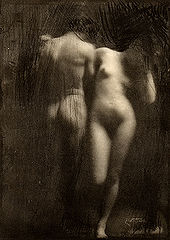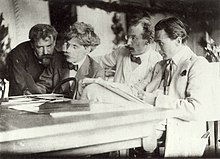Frank Eugene
Frank Eugene (born September 19, 1865 in New York , † December 16, 1936 in Munich ; actually Frank Eugene Smith ) was an American / German photographer , painter and etcher . Eugene is counted among the Pictorialists and is considered an important representative of the artistic photography of the fin de siècle .
Live and act
Eugene studied at the Academy of Fine Arts in Munich in 1886 . During his studies he became interested in the medium of photography. In 1889 he had his first solo exhibition at the Camera Club of Alfred Stieglitz . Critics called his pictures "non-photographic photographs". In 1894 he finished his studies and returned to New York, where he worked for several years as a set designer and portrait painter, specializing in the portrayal of well-known theater actors. From 1900 he was back in Germany and became involved in art photography. In 1902 he founded the Photo Secession in New York together with Alfred Stieglitz and Edward Steichen .

In 1906 Eugene finally settled in Germany because he found recognition for his Art Nouveau painting here; in the same year he took German citizenship. From 1907 Eugene taught at the teaching and research institute for photography in Munich and gave lectures on pictorialist photography. In the same year Eugene, Stieglitz, Steichen and Heinrich Kühn met to adjust the German art photographers to the American guidelines. In 1913 he founded the chair for artistic photography at the Academy for Graphic Arts and Book Industry in Leipzig and continued his teaching there. This chair, specially created for Eugene, was the first of its kind in the world.
Frank Eugene died of heart failure in Munich in 1936.
plant
Eugene became internationally known for his heliogravures published in the photo magazine Camera Work between 1904 and 1910 , in which he oriented himself on the romanticizing style of painting. To this end, Eugene edited his photographic negatives with an eraser needle and increased the graphic character of the print. He liked to give his work a sensual aspect reminiscent of nude studies . Well-known works in this manner are Adam and Eve (1898) or The Horse (1901).
Eugene's works can be seen in the Alfred Stieglitz Collection in the Metropolitan Museum of Art , in the Hamburg Museum for Art and Industry and in the Prenten Cabinet of the Leiden Rijks University, as well as in other museums.
literature
- Hans Brandenburg : Munich shone: memories of youth . Neuner, Munich 1953, pp. 269-273.
- Frank Eugene: The Dream of Beauty ; ed. from the Munich Photo Museum; Nazraeli Press 1998, ISBN 3923922418 .
- Janna Oltmanns: Frank Eugene - Adam and Eve. A fragmentation of the first human couple . Tectum, Marburg 2008, ISBN 978-3-8288-9827-1 .
Web links
- Frank Eugene at Google Arts & Culture
- Frank Eugene at artfacts.net
- Frank Eugene at photography-now.com
- Frank Eugene biography
Individual evidence
- ^ Weston Naef: The Collection of Alfred Stieglitz: Fifty Pioneers of Modern Photography . Metropolitan Museum of Art, New York 1978, pp. 345-346.
| personal data | |
|---|---|
| SURNAME | Eugene, Frank |
| ALTERNATIVE NAMES | Eugene Smith, Frank (real name) |
| BRIEF DESCRIPTION | American photographer, painter, and etcher |
| DATE OF BIRTH | September 19, 1865 |
| PLACE OF BIRTH | New York City |
| DATE OF DEATH | December 16, 1936 |
| Place of death | Munich |


